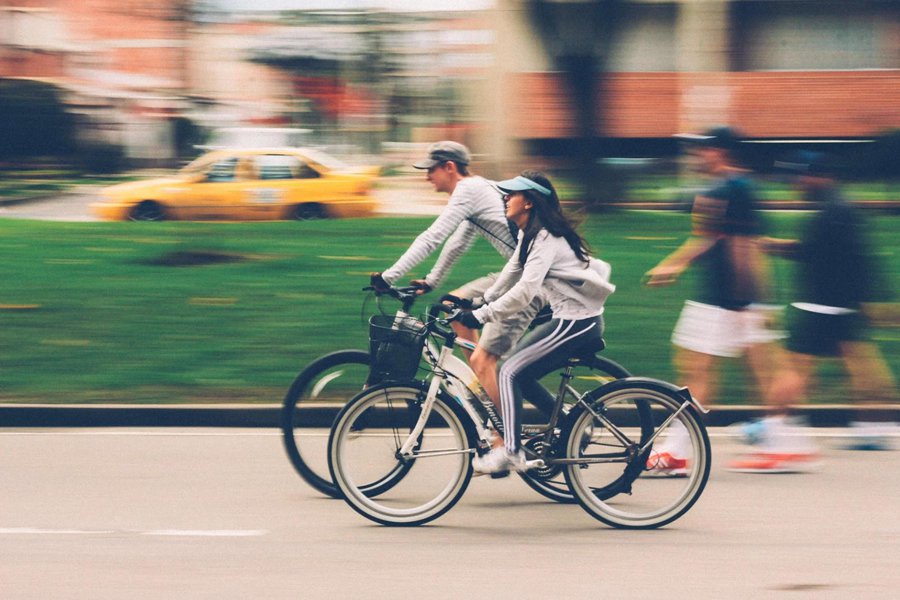
Spring is coming! Are you excited and can’t wait to go out for playing or exercising? In spring, the weather is getting warmer and warmer, and sunshine gradually sparkles brightly. There is no doubt that spring is a perfect season for various outdoor activities.
But we’re just finishing a cold Winter, and our bodies are recovering from the state of peace, so we must pay much more attention to avoid sports hurt, especially physical exercises. If you are going to do some outdoor in this warm and sweet season, remember to protect yourselves in proper ways.
Why do we need to
pay much attention to the spring workout?
Although the temperature rises in spring, the temperature difference between morning and night may also be huge. Exercise will make the body to heat up and sweat. If you are too lazy to do some daily sports, you may catch a cold or the other disease. Wear sports clothes and shoes with strong wind and coldness protection to avoid excessive heat loss during intense exercise and physical discomfort.
At the same time, because our bodies have just passed a cold winter, the body function is still in the recovery period, many people are not suitable for starting intense exercise immediately.
You can start with some intense recovery training, and at the same time, don’t forget to fully warm up and pull before exercise stretch, especially to move the knee joint for a minute or two, to relax the joint and adjust the body state, to avoid joint injury and body strain.
Besides, because the plants sprout in spring and many flowers are blossoming. Thus the pollen content in the air increases; people who are allergic to it should pay much attention. If possible, try to exercise indoors, do not stay outside for a long time.
And if you have to go out just don’t forget to wear a mask and wash your hands, change clothes on time when you get back.
What kinds of sports are suitable for spring?
As we talked about above, our bodies are just finishing a cold winter and still under recovery; therefore, in this period, we’re not so suitable for strenuous exercise. So what kinds of sports we could do in spring?

1. Stretching your body, yes, this is also a good sport. Get up every morning to stretch. All the muscles of your body can get active, coupled with deep breathing, which not only can move the body joints but also can refresh the mind and start a new day.

2. Walking, as mentioned earlier, the spring temperature rises, and the sun is getting warmer. Many people will go out to enjoying spring at this time. If there is not much time and energy, then you could just walk downstairs around your house. Middle-aged and older people with better physical fitness are suitable for brisk walking, with a speed of 5 to 6 kilometers per hour, walking about 120 steps per minute.
Adhering to brisk walking can improve the heart and lung function of the human body, reduce body fat rate, and reduce cardiovascular and cerebrovascular diseases, the incidence of chronic diseases such as diabetes, hypertension, etc. Older adults with the weak constitution should choose to stroll, about 80 steps per minute at a speed of 2 to 3 kilometers per hour, which can help stabilize the mood, eliminate fatigue, and also have the effect of strengthening the stomach and digesting.

3. Cycling is a typical aerobic exercise that can enhance cardiopulmonary function and make the body shapely. It has a significant effect on preventing the occurrence of chronic diseases such as heart disease, hypertension, and diabetes.
Cycling for daily fitness purposes, the heart rate is controlled below the anaerobic threshold heart rate level, you can use 170-age to control exercise intensity, each exercise time is about 20 ~ 40 minutes, if the exercise intensity is low, you can extend it. However, it is not recommended to exercise too long to prevent fatigue damage.

4. Jogging has a good effect on improving cardiopulmonary function, lowering blood lipids, improving body metabolic capacity, enhancing body immunity, and delaying aging. Jogging also helps regulate brain activity, promote gastrointestinal motility, enhance digestive function, and eliminate constipation.
Jogging in spring, you can still see the green eyes, which is also good for the restoration of vision.

5. Climbing is an excellent aerobic exercise. If you climb on the slope at a speed of 2 kilometers per hour for 30 minutes, the energy consumed is about 500kcal, which is equivalent to the energy consumed by 45 minutes of swimming. Although climbing mountains is good, there are also some exquisite. It is easy to hurt the body if the strength is not well grasped. Therefore, it is necessary to prepare for activities before climbing the mountain and to move the muscles and joints.
Similarly, after climbing the mountain, you must also do some sorting and relaxation activities, such as continuing to walk on the flat ground after going down the mountain. It is most suitable to keep the central rate at 120-140 times/min during the climbing. People who are overweight and have poor knee joints should reduce the number and duration of mountaineering, and use trekking poles when climbing to help share the weight to reduce the burden on the knee.
Besides these five sports mentioned above, there are still many other spots we could do, for example, rope skipping, yoga, and some physical training like HIIT. Not only outdoor sports but also indoor exercises are good choices, and you can choose what you like based on your training conditions.
What fruits and vegetables of spring are good for fitness?

As we all know, diet plays an important role in our daily life. According to the study of, Harvard T.H. Chan School of Public Health, a healthy diet should be rich in vegetables and fruits which could lower blood pressure, reduce the risk of heart disease and stroke, prevent some types of cancer, lower risk of eye and digestive problems, and have a positive effect upon blood sugar, which can help keep appetite in check.
Eating non-starchy vegetables and fruits like apples, pears, and green leafy vegetables may even promote weight loss. Their low glycemic loads prevent blood sugar spikes that can increase hunger. So what fruits and vegetables are of the season and good for your health?
- Asparagus, as a vegetable used very often in the meal, it’s a perfect choice for health. It contains a prebiotic called inulin that aids digestive health by promoting the growth of good bacteria. It is also loaded with anti-inflammatory phytonutrients and vitamins and minerals that act as antioxidants.
- Artichokes, known as “king of vegetables,” provide folate, fiber, vitamin C, and vitamin K. They contain the disease-fighting flavonoids quercetin and anthocyanins. Artichokes are a source of lutein, which promotes heart health, and cynarin and silymarin, which have been linked to liver health.
- Beets, look warm, and taste warm, too. It containsfiber, potassium, and folate. Purple and red varieties also contain betacyanin, a phytochemical found to protect against cancer and reduce the inflammation linked to heart disease.
- Garlic flowers grow from garlic bulbs, forming a long green curly stem above the ground. Like garlic, flowers are also part of the Allium vegetable family. These foods contain sulfur compounds that can act as antioxidants against disease.
- Pea provides manganese, folic acid, fiber, and vitamin B6. They are considered a source of alpha-linolenic acid, which is an omega-3 fatty acid. Pea also contains coumarin, a phytochemical that is associated with a reduced risk of stomach cancer.
- Turnips, like kale and brussels sprouts, belong to cruciferous vegetables. These foods contain glucosinolates, which have been found to prevent cancer. Radish is also a source of vitamin C and fiber.
- Spinach, this green leafy vegetable, is a source of vitamin C and vitamin K. It provides carotenoids β-carotene, lutein, and zeaxanthin, which can act as antioxidants and promote healthy vision. Spinach has been found to prevent aggressive prostate cancer.
- Strawberry provides vitamin C, folic acid, and fiber. They contain more than 18 phytonutrients, which are related to the prevention of cardiovascular diseases and cancer. Strawberries have also been found to help control blood sugar.
Of course, there are many other fruits and vegetables to choose from, and it’s necessary to pay much attention to diet not only in spring but also in every season, so just remember to develop a nice habit of the diet which will help you start a year better.
Useful tips for spring training

- Know much about your fitness level and start with the basics. If you are under the age of 50 and in good health, there is no need to turn to doctors for a lot of professional knowledge, but it’s recommended before starting a new exercise program. That is, if you’re young not only at age but also in the fitness, start with some basic training but if you’re going to improve your training level, talking to doctors for help is recommended. Also, if you’re over 50 or have some health issues — like high blood pressure, heart problems, dizzy spells, or arthritis — talking to your doctor before your fitness training is a must.
- Make a plan and set goals for yourself. It is known to all that it’s easier said than done. Planning your fitness program in detail not only could help you to track your progress easily, but also will give you encouragement sometime. Insisting on is not an easy case, so we need something to remind us to keep on full of power and confidence.
- Remember to choose suitable clothes, shoes and other accessories for sports. The weather of spring is changeable, so it’s necessary to follow weather broadcasts now and then, especially when you’re going to do some outdoor activities. Sunglasses prevent hurt from strong sunshine, and the helmet could protect your head when you’re cycling, and so on. The dress is not only comfortable but also safe for sports.
- Do a full warm-up before starting exercise and stretch after workouts; these activities could help you to motivate and relax your body to avoid sports injuries. And the long time of exercise will cause a huge loss of water to bodies, so don’t forget to drink plenty of water per day, according to studies, it is recommended to drink a least 32 ounces a day. Why don’t you take a water bottle with a time marker to remind you of keeping hydrated? You could also consume some sports drinks if you need to want some energy supplies.
- Stay safe. If you are exercising late evening, keep to well-lit areas and wear bright and reflective clothing. Always does exercise with a friend. But always tell someone where you are going. Avoid listening to music while running outdoors. Not hearing what’s going on around you can make you vulnerable. If rain or ice is making exercise dangerous, do it another day. The weather might be better tomorrow, but an injury could take weeks to heal.
- Positive attitude towards life makes us tougher and happier, in this warm and beautiful season, let’s smile and keep going together!

